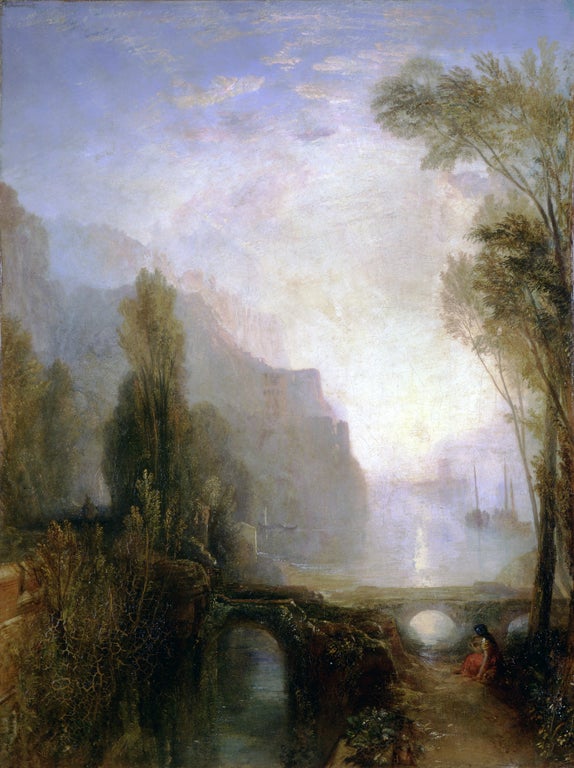Hockney and Turner take the scenic route
It's a good year for British landscapes, but Munch and Mondrian lead the Continental challenge

Fans of English landscape are in for a bumper year, kicking off in January with the Royal Academy's David Hockney RA: A Bigger Picture (21 January to 9 April).
That's bigger as in even more enormous: Hockney's ambition, played out over the years on the Academy's walls, seems to be to invent a form of landscape that is life-sized, or slightly larger. This time, the arch-lyricist of the Marlboro Light will dwarf the RA's galleries not only with huge paintings of East Yorkshire but with multi-camera films – a sort of fly's-eye view of Bridlington and surrounds. If you are a Hockneyite, prepare to be amazed.
An avowed follower, Hockney himself may well be heading south to take in a brace of Turner shows. The first, at the Turner Contemporary in Margate, re-slices the J M W cake by looking at the master's response to earth, air, fire and water – the 95 works in Turner and the Elements (28 January to 13 May) will ponder its subject's interest in contemporary science. On a more aesthetic note, the National Gallery's Turner Inspired: In the Light of Claude (14 March to 5 June) looks at its subject's response to – in the eyes of the time, at least – the greatest of the Franco-Roman landscapists, Claude Lorrain. Turner bequeathed the National Gallery two of his canvases on condition that they be hung between a pair of Claudes: this show will restore that hang, revealing an unexpected European taste in this most English of English landscapists.
If Hockney baulks at long trips south in a no-smoking train, then there is a part-Turner show just over the Pennines later in the year. Tate Liverpool's Turner Monet Twombly (22 June to 28 October) will trace links between the three titular artists' work, although quite what these are has yet to be revealed. Filling in the historical gap between the last two of the trio is the National Gallery of Scotland's Van Gogh to Kandinsky (14 July to 14 October), the first exhibition in Europe to dedicate itself to Symbolist landscape – Gauguin's Breton fields, Van Gogh's starry nights, et cetera. And if the Symbolists appeal, then the varied anxieties of Edvard Munch – although not, alas, The Scream – will be on show at Tate Modern at much the same time (28 June to 14 October). By including Munch's little-known film and photographic work, the Tate hopes to reinvent Symbolism as an early Modernist experiment rather than a late Victorian one.
Perhaps the most interesting exhibitions of 2012 will be a pair which set out to locate British art in the to-ings and fro-ings of the European avant garde. It is often assumed that 20th-century British artists went their own sweet, insular way, doggedly painting chalk downs and Camden Town while beastly Continentals messed about with Cubism and Constructivism and that sort of thing. As the Courtauld Gallery's Mondrian//Nicholson: In Parallel (February to May) will show, this was by no means the whole truth.
In the mid-1930s, Ben Nicholson and his coterie fell for the severities of Mondrian's grids and rectangles in a big way, eventually spiriting the Dutchman to London for a two-year stay in 1938. There was a moment when Alfred Barr, founder of the Museum of Modern Art in New York, believed that England would be the natural haven for pure abstraction: the war and English reaction proved him wrong. Nicholson is back again in Tate Britain's Picasso and Modern British Art (15 February to 15 July), which looks at the abiding impact of the Spanish wizard on British artists from Duncan Grant to David Hockney: around 100 of their works will be shown side-by-side with 60 of Picasso's. His influence was not simply via books: Picasso first visited London in 1919 when he was doing theatre designs for Diaghilev, and he came back in 1950 to stay with Lee Miller and Roland Penrose on their Sussex farm.
Of course, no year would be complete without a smattering of Young [sic] British Artists, and 2012 has its full complement. Most contentiously, David Shrigley will be given the run of the Hayward Gallery's upper floors in a show called Brain Activity (1 February to 20 May). Shrigley's faux-naive cartoons and stuffed Jack Russells divide critical opinion, some seeing him as a witty subverter of daily life, others merely as a bad comic with ideas above his station. Decide for yourselves. Downstairs, you can ponder the more thoughtful installations, banners, posters and protest-pieces of Jeremy Deller in a mid-career retrospective of the 2004 Turner prize-winner's work (22 February to 13 May).
Predictably, the plum Britart prize goes to its sulphurous parent, Damien Hirst. His show – called, in awe-struck tones, Damien Hirst (4 April to 9 September) – will fill a floor of Tate Modern with 20-odd years' worth of the artist's sharks/pill cabinets/spots/ butterflies for a full five months: an extraordinary honour for a living artist. Happy New Year, anyway.
Next Week:
Charles Darwent looks at Graham Sutherland's works on paper at Modern Art Oxford
Watch out for...
A revival of interest in the Italian artist Alberto Burri is on the cards with a major show at the Estorick, north London (13 Jan to 7 Apr). Burri was among the first to use industrial materials, cutting, burning and sewing them with the precision born of his doctor's training. CP
Subscribe to Independent Premium to bookmark this article
Want to bookmark your favourite articles and stories to read or reference later? Start your Independent Premium subscription today.

Join our commenting forum
Join thought-provoking conversations, follow other Independent readers and see their replies